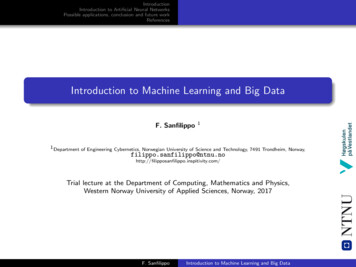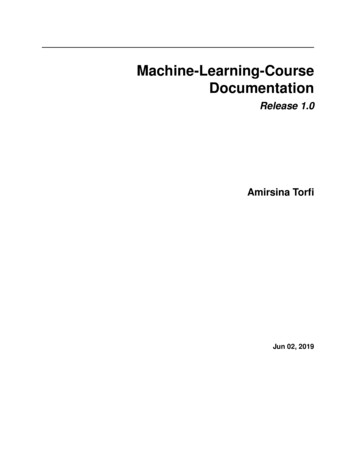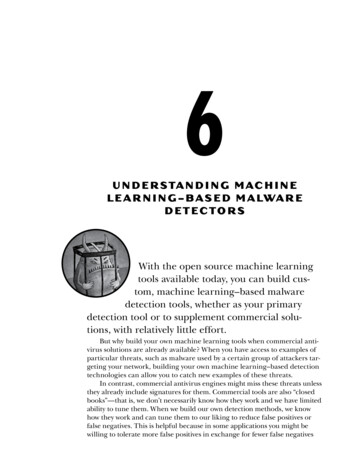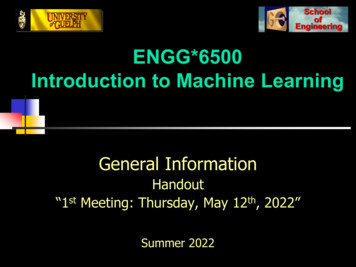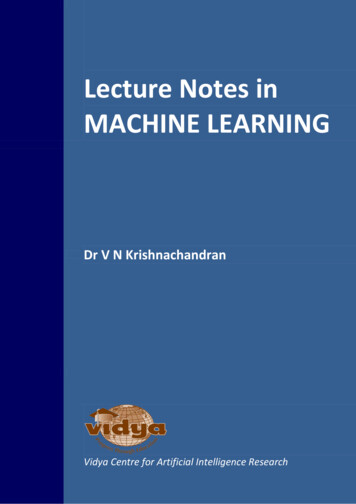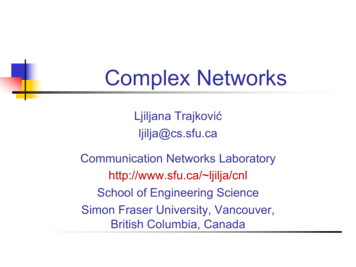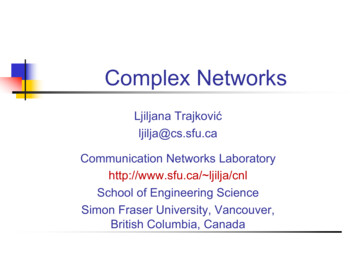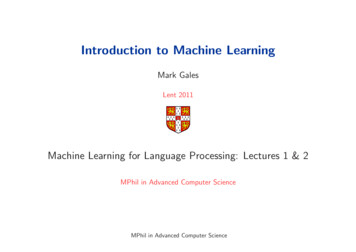
Transcription
Introduction to Machine LearningMark GalesLent 2011Machine Learning for Language Processing: Lectures 1 & 2MPhil in Advanced Computer ScienceMPhil in Advanced Computer Science
Module L101: Machine Learning for Language ProcessingDecision MakingIn this world nothing can be said to be certain, except death and taxes.- Benjamin Franklin We make decisions under uncertainty all the timegambling (not recommended), weather forecasting (not very successfully)insurance (risk assessment), stock marketNeed to formalise “intuitive decisions” mathematically Basically, how to quantify and manipulate uncertainty. Various tasks we can consider– classification: predict class from observations– regression (prediction): predict value from observations– clustering: group observations into “meaningful” groupsMPhil in Advanced Computer Science1
Module L101: Machine Learning for Language ProcessingMachine Learning One definition is (Mitchell):“A computer program is said to learn from experience (E) with some classof tasks (T) and a performance measure (P) if its performance at tasksin T as measured by P improves with E”alternatively“Systems built by analysing data sets rather than by using the intuitionof experts” Multiple specific conferences:– {International,European} Conference on Machine Learning;– Neural Information Processing Systems;– International Conference on Pattern Recognition etc etc; as well as sessions in other conferences:– ICASSP - machine learning for signal processing.Cambridge UniversityEngineering DepartmentMPhil in Advanced Computer Science2
Module L101: Machine Learning for Language ProcessingNatural Language Processing Applications Natural language processing becoming increasingly popular (important) Many possible applications:––––––spam email detection;named-entity recognition;machine translation;relation extraction;information retrieval;sentiment analysis; Generally need to structure and annotate vast quantities of text data– sometimes used in combination with speech and image processingCambridge UniversityEngineering DepartmentMPhil in Advanced Computer Science3
Module L101: Machine Learning for Language ProcessingMachine TranslationRafales de marque - lecteur dans la technologie de.http://66.249.91.104/translate c?hl en&langpai.Marquer les rafalesLes rafales de marque est un lecteur dans la technologie de l'information dans le laboratoired'intelligence de machine (autrefois le groupe de vision et de robotique de la parole (SVR)) etun camarade de l'université d'Emmanuel. Il est un membre du groupe de recherche de laparole ainsi que les jeunes de Steve de membres de personnel de corps enseignant, la régfionboisée et la facture Byrne de Phil.Une brève biographie est accessible en ligne. Interesting application– statistical approaches work well[Recherche projets publications étudiants enseignant contact]Intérêts de recherches Translation of my web-page (in 2007)Reconnaissance de la parole continue de grand vocabulaireReconnaissance de la parole robusteAdaptation d'orateurÉtude de machine (en particulier choix modèle et méthodes grain-basées)Identification et vérification d'orateur– Mark Gales becomes To mark the gusts– Phil Woodland, Steve Young, Bill Byrne– (translates correctly in 2009)Une brève introduction à la reconnaissance de la parole est accessible en ligne.dessusProjets de rechercheProjets en cours :Bruit ASR robuste (Europe Ltd de recherches de Toshiba placée)Traitement averti d'environnement rapide et robuste (Europe Ltd de recherches deToshiba placée)Position d'associé de recherches disponibleAGILE (projet placé par GALE de DARPA)Version 3 de HTK - HTK V3.4 et exemples sont disponibles. Part of this MPhil course.Projets récemment réalisés :CoreTex (améliorant la technologie de reconnaissance de la parole de noyau)Transcription audio riche de HTK(Projet placé par OREILLES de DARPA) - pages Weblocauxdessus1 of 317/09/07 15:08Cambridge UniversityEngineering DepartmentMPhil in Advanced Computer Science4
Module L101: Machine Learning for Language ProcessingSentiment AnalysisTwitter h?query angrySign in HelpOpen Feedback DialogType in a word and we'll highlight the good and the badangrySearch Save this searchSentiment analysis for angry Alternative application– statistical approaches again work wellTweets about: angrygabbs toolive: Soooooooooooooooooooooooo he pissed me off this morning ndnow I'm just angry “Twitter Sentiment” for angryPosted 17 seconds agobyaDonghaelover: sm * sh Indonesia mimic the style of super junior I was veryangry @TEUKdom @special1004 @donghae861015 @KyuhyunBiased@GaemGyu– lots of tweets about angry birds game– sentiment accuracy reasonablePosted 22 seconds agoAmbahJambah: love watching @remow49 play angry birds while we should beworking.Posted 23 seconds agobabyinasack: @Maisarahh Cuteboy? No. I'm angry.Posted 25 seconds agohondanhon: People on the internet are wrong, it's making me angry, and I can'tbe arsed correcting them.Posted 26 seconds agoayneeahmd: I won't get angry if you found someone better. I'm happy if you'rehappy. #nowthatslove Cheeyyy! (:Posted 35 seconds agotwrafferty: @Eamonn Forde Fittingly, I read this tweet on a bus while a helmetplayed Angry Birds on his netbook beside mePosted 40 seconds agoThe results for this query are: AccurateInaccurate1 of 714/01/2011 14:47Cambridge UniversityEngineering DepartmentMPhil in Advanced Computer Science5
Module L101: Machine Learning for Language ProcessingNatural Language ProcessingWhy is natural language processing an interesting machine learning task? “Standard” machine learning tasks are of the form– clearly defined set of observations x– “reasonable” number of classes ω1, . . . , ωK Consider statistical machine translation with source vocabulary Vs targetvocabulary Vt– for target sentence of 10 words Vt10 possible sentences– Vs word features, Vs2 word-pair features, Vs3 word-tuple features, .– vast number of possible classes, vast number of possible features These initial 2 lectures will not address these problems directly– standard machine learning described– language processing extensions to will be described in future lecturesCambridge UniversityEngineering DepartmentMPhil in Advanced Computer Science6
Module L101: Machine Learning for Language ProcessingBasic Discrete Probability Discrete random variable x takes one value from the set, with probabilitiesX ω1, . . . , ωK ;pj Pr(x ωj ),j 1, . . . , KProbability mass function, P (x), describes the set of probabilities, satisfiesXP (x) 1,P (x) 0x XProbability density function, p(x), equivalent for continuous random variables For random variables x, y, z needy)conditional distribution: P (x y) PP(x,(y)joint distribution P (x, y)Pmarginal distribution P (x) y Y P (x, y)chain rule P (x, y, z) P (x y, z) P (y z) P (z)Cambridge UniversityEngineering DepartmentMPhil in Advanced Computer Science7
Module L101: Machine Learning for Language ProcessingMachine Learning FrameworkClassificationFeature ExtractionDocumentFeaturesSentiment There are two stages in a pattern recognition framework:– feature extraction: a feature vector, x, is derived from the “observations”;– classification: a class ω is identified given the feature vector x: Example: sentiment analysis– w is the document (words)– x is the a binary vector whether a particular word is in the document– ω is the sentiment (e.g. angry) Need to design a suitable feature vector and classifier for task.Cambridge UniversityEngineering DepartmentMPhil in Advanced Computer Science8
Module L101: Machine Learning for Language ProcessingTraining and Evaluation Data The basic machine learning framework has two sets of data:1. Training data: is used to train the classifier - data may be:– supervised: the correct classes of the training data are known.– unsupervised: the correct classes of the training data are not known– reinforcement learning: don’t learn a model - directly learn an action!2. Test data: held-out data for evaluating the classifierSupervised training data will be mostly considered in this course It is important that the training and test data do not overlap– performance on training data better than on held-out data– becomes more important as the classifiers become more complex– development data sometimes used to tune parameters Aim to build a classifier that performs well on held-out data, generalise.Cambridge UniversityEngineering DepartmentMPhil in Advanced Computer Science9
Module L101: Machine Learning for Language ProcessingGeneralisation Performance typically goes as leftError Rate– increasing model parameters,– improves training data performance– but not always test data performanceHeld out data What complexity of classifier to use?Training dataNumber of Parameters Consider various regions of the graph1. Too Simple: The models used are relatively simple. The performance on thetraining and test data is about the same as the models are “well” trained.2. Optimal: This is where the error rate on the test data is at a minimum.This is where we want to be.3. Too Complex: The models perform very well on the training data. Howeverthe models perform badly on the test data.Cambridge UniversityEngineering DepartmentMPhil in Advanced Computer Science10
Module L101: Machine Learning for Language ProcessingMachine Learning Based Decisions Need a systematic well-motivated approach for making decisions - consider– classifier: form and how to train the classifier– decision rule given a classifier: how to use it Consider a system where– observation: feature vector of dimension d, x– class labels: there are K classes, denoted by ω1, ω2, ., ωK . Classifiers for making decisions can be broadly split as:– Generative models: a model of the joint distribution of observations andclasses is trained, P (x, ωj ).– Discriminative models: a model of the posterior distribution of the classgiven the observation is trained, P (ωj x).– Discriminant functions: a mapping from an observation x to class ωj isdirectly trained. No posterior probability, P (ωj x), generated just classlabels.Cambridge UniversityEngineering DepartmentMPhil in Advanced Computer Science11
Module L101: Machine Learning for Language ProcessingBayes’ Decision Theory Given a classifier create a decision rule to minimise average probability of error.XXP (error) P (error, x) P (error x)P (x)x Xx X– for a two class problem, the conditional probability of error can be written P (ω1 x) if we decide ω2P (error x) P (ω2 x) if we decide ω1 Minimising P (error x) for each x minimises the average probability of error.– this gives Bayes’ decision rule, which for a two class problem isDecide Class ω1 if P (ω1 x) P (ω2 x),Class ω2 otherwiseω1P (ω1 x) 1 P (ω2 x) ω2– for multiple classes select according to ω̂ argmaxω {P (ω x)}Cambridge UniversityEngineering DepartmentMPhil in Advanced Computer Science12
Module L101: Machine Learning for Language ProcessingGenerative Models For generative models the joint distribution is found - often expressed asP (x, ωj ) P (x ωj )P (ωj ) Form of classifier considered has two parts– prior probabilities: an idea of how frequent each class is, P (ω1), . . . , P (ωK ).– class-conditional (likelihood) probability: the PMF of the feature vector foreach class P (x ω1), . . . , P (x ωK ). For an unknown observation x, Bayes’ rule allows the calculation of posteriorprobability of class membership.P (x ωj )P (ωj )P (ωj x) PK,k 1 P (x ωk ) P (ωk )Cambridge UniversityEngineering Departmentj 1, 2, ., KMPhil in Advanced Computer Science13
Module L101: Machine Learning for Language ProcessingNaive Bayes’ Classifier Simple form of generative model:– joint distribution: P (x, ωj ) P (ωj )– classification: P (ωj x) P (ωj )QdQdi 1 P (xi ωj )i 1 P (xi ωj ) Elements of the feature vector conditionally independent given the classωx1x2 write as a Bayesian Network (BN)x3––––shaded observed variableunshaded unobserved variablecircle continuous variablesquare discrete variable More on Bayesian Networks (and Graphical Models) later in the moduleCambridge UniversityEngineering DepartmentMPhil in Advanced Computer Science14
Module L101: Machine Learning for Language ProcessingProbability Distributions For generative models need to decide form of conditional distribution P (x ωj )– (d-dimensional) feature vector may be discrete or continuous Discrete distributions (probability mass functions) - primary interest here– Multivariate-Bernoulli distribution: xi {0, 1},P (x ωj ) dYpxjii (1 pji)1 xi ;0 pji 1i 1– Multinomial distribution: xi {0, . . . , n}n!P (x ωj ) QddYi 1 xi ! i 1pxjii ,n dXxi,i 1dXpji 1,pji 0i 1 Continuous distribution, xi [ , ], less interest on this moduleCambridge UniversityEngineering DepartmentMPhil in Advanced Computer Science15
Module L101: Machine Learning for Language ProcessingMaximum Likelihood Training The class-conditional distribution P (x ωj ) needs to be trained– only the data from the class of interest used– for class ωj with n training examples x1, . . . , xnλ̂j argmaxλ(nYP (xτ λ)τ 1) argmaxλ(nX)log (P (xτ λ))τ 1 For the multivariate Bernoulli distribution: λj {pj1, . . . , pjd}λ̂j argmaxλj(n XdXxτ i log(pji) (1 xτ i) log(1 pji)τ 1 i 1Differentiating wrt λj and equating to zero yields: pji Cambridge UniversityEngineering DepartmentMPhil in Advanced Computer Science1n)Pnτ 1 xτ i16
Module L101: Machine Learning for Language ProcessingImproving the Basic Model Incorporating a Prior: What happens if a count is zero?– simplest solution to initialise counts with a constant α: for Bernoullipji 1α nα nXxτ iτ 1!– more details on this topic in discussion of language models Mixture Model: more “powerful” distribution combining multiple distributions:P (x ωj ) MXP (cm ωj )P (x cm, ωj )m 1– component cm has prior, P (cm ωj ) and probability distribution, P (x cm, ωj )– more details on this topic in the lectures on graphical modelsCambridge UniversityEngineering DepartmentMPhil in Advanced Computer Science17
Module L101: Machine Learning for Language ProcessingLimitations of Generative Models An obvious question is:If Bayes’ decision rule minimises average probability of errorand we can train generative models - why do anything else?Plus often able to estimate parameters simply by counting! The classifier is the minimum error classifier only if––––form of the class-conditional distribution is correcttraining sample set is infinitetraining algorithm finds the correct parameterscorrect prior is usedNone of these are usually true!, but still used for some tasksCambridge UniversityEngineering DepartmentMPhil in Advanced Computer Science18
Module L101: Machine Learning for Language ProcessingDiscriminative Models Classification requires the class-posterior P (ωj x)– can just directly model the posterior distribution– avoids the complexity of modelling the joint distribution P (x, ωj ) Form of model called a discriminative model Many debates of generative versus discriminative models:––––discriminative model criterion more closely related to classification processnot dependent on generative process being correctjoint distribution can be very complicated to accurately modelonly final posterior distribution needs to be a valid distribution Initially consider classifiers that yield linear decision boundariesCambridge UniversityEngineering DepartmentMPhil in Advanced Computer Science19
Module L101: Machine Learning for Language ProcessingLinear Decision Boundaries Decision boundaries partition the feature-space into regions– associated with each region is a class label– linear decision boundaries use:lines (d 2); planes (d 3); hyper-planes (d 3) to determine regions Initially only binary (2-class) classification tasks will be consideredConsider linear decision boundary whereg(x) wTx bClass 1x2Decisions are made based onDecide class ω1 g(x) 0class ω2 g(x) 0Parameters of decision boundary b & wCambridge UniversityEngineering DepartmentMPhil in Advanced Computer ScienceClass 2x120
Module L101: Machine Learning for Language ProcessingLogistic Regression/Classification For binary classification - logistic regression classification is a simple form– class posterior probability a function of the perpendicular distance to thedecision boundaryexp( (wTx b))P (ω2 x) 1 exp( (wTx b))1;P (ω1 x) T1 exp( (w x b))– linear decision boundary - need to find λ {w, b}. Often parameters combined into single vectorsx̃ Cambridge UniversityEngineering Departmentx1 ,w̃ wb ,w̃Tx̃ wTx bMPhil in Advanced Computer Science21
Module L101: Machine Learning for Language ProcessingForm of Posterior The posterior distribution of class 1 and perpendicular distance to the decisionboundary a sigmoid function11101000.90.81P (ω1 x) 1 exp( ρz)0.70.60.5where ρz wTx b0.40.30.2 diagram shows variations with ρ0.10 10 8 6 4 20246810 Posterior is only a function of perpendicular distance to the decision boundary Altering the value of the priors simply moves the sigmoid to the right or leftCambridge UniversityEngineering DepartmentMPhil in Advanced Computer Science22
Module L101: Machine Learning for Language ProcessingMaxEnt Model A multi-class generalisation of logistic regression is the MaxEnt model 1TP (ωj x) exp wj x bj ;ZZ KXexpwkTx bkk 1 Z is the normalisation term A more general form of MaxEnt model considers class-specific features– can use a feature function of the observation and class, f (x, ωj )1P (ωj x) expZDXi 1!λifi(x, ωj ) ;Z KXk 1expDXi 1λi fi(x, ωk )!– D is the size of the combined feature-vector for all classesCambridge UniversityEngineering DepartmentMPhil in Advanced Computer Science23
Module L101: Machine Learning for Language ProcessingMaxEnt Model (cont) Feature-functions can represent the simple linear form λ w1b1.wKbK ; f (x, ω1) x10.0 ; f (x, ωk ) 0.x10. Relationship to logistic regression (note binary case, restricted feature function) Texp w1 x b1 P (ω1 x) TTexp w1 x b1 exp w2 x b2 Cambridge UniversityEngineering Department11 exp ((w2 w1)Tx (b2 b1))MPhil in Advanced Computer Science24
Module L101: Machine Learning for Language ProcessingDiscriminative Model Training Similar criterion to ML-training of generative models– maximise posterior of the correct class (rather than generating the data)λ̂ argmaxλ(NX)log (P (yτ xτ , λ))τ 1where yτ {ω1, . . . , ωK } and training data {(x1 , y1), . . . , (xN , yN )} Useful properties– multi-class training of parameters λ– all training examples used to derive all the model parameters– different features may be used for different classes(generative model requires same feature-space)Cambridge UniversityEngineering DepartmentMPhil in Advanced Computer Science25
Module L101: Machine Learning for Language ProcessingTraining MaxEnt Models Training MaxEnt model is a convex optimisation problem– one solution to train parameters is generalised iterative scaling(l 1)λi(l) λi 1logCPNτ 1 fi (xτ , yτ )PN PK(l)τ 1k 1 P (ωk xτ , λ )fi (xτ , ωk )!– iterative approach (parameters at iteration l are λ(l)) (strictly) requires that the features add up to a constantDXfi(xτ , ωk ) C, τ, ki 1– extensions relaxes this requirements, e.g. improved iterative scalingCambridge UniversityEngineering DepartmentMPhil in Advanced Computer Science26
Module L101: Machine Learning for Language ProcessingDiscriminative Functions Aim to directly minimise the error rate– all we care about for classification– don’t need to determine class posteriors, P (ωj x), just decision boundaries Wide range of possible optimisation schemes/criteria (Duda, Hart and Stork)– perceptron algorithm described in this lecture Some disadvantages to not obtaining a posterior probability: issues with– reject option: don’t quote answer if posterior below a threshold– compensating for class priors: priors are sometimes estimated on differentdata (e.g. language models)– combining models: sometimes build and combine multiple systems usingposteriors (could use voting .)Cambridge UniversityEngineering DepartmentMPhil in Advanced Computer Science27
Module L101: Machine Learning for Language ProcessingCost Functions Need to decide on the criterion, cost function, to train the decision boundaryCost 1 (incorrect)Cost x b (Incorrect)Cost 0 (correct)Cost 0 (correct)bideal cost functionperceptron cost function Would like to minimise the error rate - ideal cost function above shown above– differentiating this function yields a delta-function– awkward to train (consider gradient descent with this) An alternative is the perceptron algorithm, which is differentiable– the distance of incorrect observations from the decision boundaryCambridge UniversityEngineering DepartmentMPhil in Advanced Computer Science28
Module L101: Machine Learning for Language ProcessingPerceptron Criterion The perceptron criterion cost for a sample is– zero when correctly classified– perpendicular distance to the decision boundary, g(x), when misclassified The distance to the decision boundary for misclassified samples– for class ω1, g(x) 0– for class ω2, g(x) 0 To simplify training the extended training observations, x̃τ , are normalisedxτ x̃τ , belongs to ω1 x̃τ , belongs to ω2w̃Txτ 0correctly classifiedCambridge UniversityEngineering Departmentw̃Txτ 0misclassifiedMPhil in Advanced Computer Science29
Module L101: Machine Learning for Language ProcessingPerceptron Algorithm The perceptron algorithm can be used to find w̃1. Choose initial value w̃(0), l 0; (w̃(l) estimate at iteration l)2. Obtain the set of mis-classified points, Y (l), using current estimate w̃(l),i.e. find all the points where w̃(l)Txτ 03. Minimise the total perceptron criterionE(w̃) X( w̃Txτ )xτ Y (l)update rule isw̃(l 1) w̃(l) Xxτxτ Y (l)4. If converged (Y (l) is empty), or max iter, STOP; else l l 1 goto (2).Cambridge UniversityEngineering DepartmentMPhil in Advanced Computer Science30
Module L101: Machine Learning for Language ProcessingPerceptron Algorithm (cont) For linearly separable data:– a linear decision boundary that correctly classifies all points exists– in this case using the algorithm guaranteed to find a solutionw̃(l 1) w̃(l) Xxτxτ Y (l)– automatically stops when the set of mis-classified points is empty. Two forms of update may be considered:– batch update: all the data is presented for each iterationthe decision boundary is only updated after all the samples have been seen– sequential update: data is presented one sample at a timethe decision boundary is updated after each sampleCambridge UniversityEngineering DepartmentMPhil in Advanced Computer Science31
Module L101: Machine Learning for Language ProcessingPerceptron Solution Region Each sample x̃τ places a constraint on possible location of solution vector. w̃Tx̃τ 0 defines a hyperplane through the origin on the “weight-space” ofw̃ vectors with x̃τ as a normal vector. Normalised data: solution must be on the positive side of every such hyperplane– it is not unique (if it exists) and lies anywhere within solution region Figure shows solution region for un-normalised and normalised data (DHS).– note change of notation: a w̃, y x̃ (left) y x (right)solutionregion y2solutionregion y2aaa tin gseparCambridge UniversityEngineering Departmentp la n ey1aneg" ply1ratin"sepaMPhil in Advanced Computer Science32
Module L101: Machine Learning for Language ProcessingStructured Data So far considered the case where the labels (training and test) are “scalar”– not always the case - consider translationSpeech recognition is difficult Lleferydd cydnabyddiaeth yn anodd Consider the number of possible classes– every possible possible “sentence” translation - vast This is also an issue with the possible features to extract– can consider pairs of words, triples etc etcNeed to make conditional-independence assumptionsCambridge UniversityEngineering DepartmentMPhil in Advanced Computer Science33
Module L101: Machine Learning for Language Processing”Theory” Part of Module These lectures give underlying theory for the seminars and associated papers Graphical Models––––––Bayesian networks and graphical models (beyond naive Bayes)Markov chains (including language modelling)mixture models (including Gaussian mixture models)hidden Markov models (including Viterbi algorithm)conditional random fieldsexpectation maximisation and variational approaches Support Vector Machines– large margin training and dual representation– kernel methods (including sequence kernels) Clustering– unsupervised approaches (including K-means clustering)– latent Dirichlet allocationCambridge UniversityEngineering DepartmentMPhil in Advanced Computer Science34
Module L101: Machine Learning for Language Processing Training and Evaluation Data The basic machine learning framework has two sets of data: 1. Training data: is used to train the classifier - data may be: - supervised: the correct classes of the training data are known. - unsupervised: the correct classes of the training data are not .



